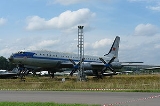
Fastest propeller-driven aircraft
Encyclopedia
A number of aircraft have claimed to be the fastest propeller-driven aircraft. This article presents the current record holders for several sub-classes of propeller-driven aircraft that hold recognized, documented speed records. Fédération Aéronautique Internationale
(FAI) records are the basis for this article. Other contenders and their claims are discussed, but only those made under controlled conditions and measured by outside observers. Pilots during World War II
sometimes claimed to have reached supersonic
speeds in propeller-driven fighters during emergency dives , but these speeds are not included as accepted records.
s as their prime propulsion device constitute a historically important subset of aircraft, despite inherent limitations to their speed. Aircraft powered by piston engines get virtually all of their thrust from the propeller driven by the engine (a few piston engined aircraft derive some thrust from the engine's exhaust gases). All aircraft prior to World War II
(except for a tiny number of early jet aircraft and rocket airplanes) used piston engines to drive propellers, so all Flight airspeed records prior to 1944 were necessarily set by propeller-driven aircraft. Rapid advances in jet engine
technology during World War II meant that no propeller-driven aircraft would ever again hold an absolute air speed record. Shock wave formation in propeller-driven aircraft at speeds near sonic
conditions, impose limits not encountered in jet
aircraft.
Jet engines, particularly turbojets, are a type of gas turbine
configured such that most of the work available results from the thrust of the hot exhaust gases. High bypass turbofans that are used in all modern commercial jetliners, and most modern military aircraft, get most of their thrust from the internal fan, which is powered by a gas turbine; turboprop
engines are similar, but use an external propeller rather than an internal fan. The hot exhaust gas from a turboprop engine can give a small amount of thrust, but the propeller is the main source of thrust.
 The Tupolev Tu-114
The Tupolev Tu-114
, a large aircraft with four turboprop engines, has a maximum speed of 870 km/h (540 mph, Mach 0.73). The 11000 kW Kuznetsov NK-12
turboprop engines designed for the Tupolev Tu-95
(and used to power the derivative Tu-114) are the most powerful turboprops ever built and drive large contra-rotating propellers
. This engine-propellor combination gives the Tu-114 the official distinction of being the fastest propeller-driven plane in the world, a record it has held since 1960.
Probably the fastest aircraft ever fitted with an operating propeller was the experimental McDonnell XF-88B, which was made by installing an Allison
T38 turboshaft
engine in the nose of a pure jet-powered XF-88 Voodoo
. This unusual aircraft was intended to explore the use of high-speed propellers and achieved supersonic speeds. This aircraft is not considered to be propeller-driven since most of the thrust was provided by two jet engines.
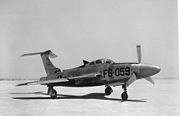 An oft-cited contender for the fastest propeller-driven aircraft is the XF-84H Thunderscreech
An oft-cited contender for the fastest propeller-driven aircraft is the XF-84H Thunderscreech
. This aircraft is named in Guinness World Records
, 1997, as the fastest in this category with a speed of 1,002 km/h (623 mph, Mach 0.83). While it may have been designed as the fastest propeller-driven aircraft, this goal was not realized due to its inherent instability. This record speed is also inconsistent with data from the National Museum of the United States Air Force
, which gives a top speed of 837 km/h (520 mph, Mach 0.70), slower than the Tu-114.
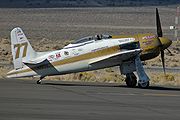 The more "traditional" class of propeller-driven aircraft are those powered by piston engines, which includes nearly all aircraft from the Wright brothers up through World War II. Today, piston engines are used almost exclusively on light, general aviation aircraft. The record for the fastest single-engined piston plane is held by a modified Grumman F8F Bearcat
The more "traditional" class of propeller-driven aircraft are those powered by piston engines, which includes nearly all aircraft from the Wright brothers up through World War II. Today, piston engines are used almost exclusively on light, general aviation aircraft. The record for the fastest single-engined piston plane is held by a modified Grumman F8F Bearcat
, the Rare Bear
, with a speed of 850.24 km/h (528.3 mph) on 21 August 1989 at Las Vegas
, New Mexico
, United States of America
.
The FAI record for the fastest piston-powered aircraft, over a long distance (1000 km (621.4 mi)) is 660.53 km/h (410.4 mph) set on 20 June 1946 by a Boeing B-29 Superfortress of the United States Army Air Forces
. Higher speed records may exist for other aircraft but are unofficial and not measured by FAI.
which managed a pedestrian 48 km/h (29.8 mph) during its first flight. The Bleriot XI
reached 75 km/h (46.6 mph) in 1909. The limits of technology during the early years of flight led to a threshold of approximately 320 km/h (198.8 mph) for the fabric-covered biplanes of the World War I era and shortly after. In 1925, US Army Lt. Cyrus K. Bettis
flying a Curtiss R3C
won the Pulitzer Trophy Race with a speed of 400.6 km/h (248.9 mph).
As aircraft designers adopted all-metal monoplanes in the 1930s, speeds jumped into the 700 km/h (435 mph) range with the Macchi M.C.72
reaching a top speed of 709 km/h (440.6 mph), which still stands as the record for piston-powered seaplanes. The Messerschmitt Me 209 V1
set a new world speed record of almost 756 km/h (469.8 mph) on 26 April 1939, and the Republic XP-47J (a variant of the P-47 Thunderbolt
) reached 813 km/h (505.2 mph) in testing, while the Supermarine Spiteful
unofficially reached 494 mph (220.8 m/s). The record-shattering flight, on 2 October 1941, of one of the Messerschmitt Me 163
rocket fighter prototypes that reached a top speed of 624 mph (279 m/s), as well as development of jet-powered fighters by both the Allies and Axis powers during World War II
, ensured that all new absolute air speed records would be held by jet or rocket-powered aircraft.
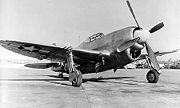
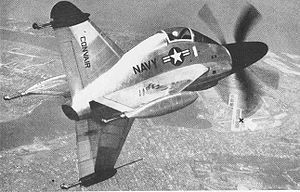
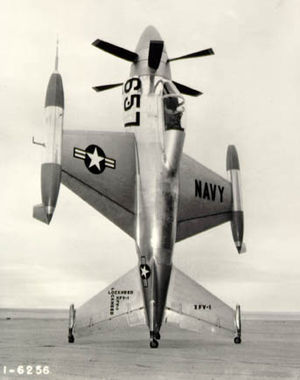 During the 1950s, two unorthodox United States Navy
During the 1950s, two unorthodox United States Navy
fighter prototypes married turboprop engines with a "tailsitting
design", the Convair XFY "Pogo"
and the Lockheed XFV "Salmon"
. Maximum design speeds of 980 km/h (608.9 mph) at 4600 m (15,091.9 ft) and 930 km/h (577.9 mph) respectively have been quoted. However, the Lockheed XFV was fitted with a less powerful engine than it was designed for and had makeshift un-retractable landing gear for horizontal takeoff and landing and the Convair XFY had a makeshift landing gear to support it in a vertical position and it was usually flown with the cockpit open in case the pilot needed to escape, since the ejection seat was thought to be unreliable. These aircraft had "compromised in-flight speed" because of the conflicting demands of vertical and horizontal flight.
Fédération Aéronautique Internationale
The Fédération Aéronautique Internationale is the world governing body for air sports and aeronautics and astronautics world records. Its head office is in Lausanne, Switzerland. This includes man-carrying aerospace vehicles from balloons to spacecraft, and unmanned aerial vehicles...
(FAI) records are the basis for this article. Other contenders and their claims are discussed, but only those made under controlled conditions and measured by outside observers. Pilots during World War II
World War II
World War II, or the Second World War , was a global conflict lasting from 1939 to 1945, involving most of the world's nations—including all of the great powers—eventually forming two opposing military alliances: the Allies and the Axis...
sometimes claimed to have reached supersonic
Supersonic
Supersonic speed is a rate of travel of an object that exceeds the speed of sound . For objects traveling in dry air of a temperature of 20 °C this speed is approximately 343 m/s, 1,125 ft/s, 768 mph or 1,235 km/h. Speeds greater than five times the speed of sound are often...
speeds in propeller-driven fighters during emergency dives , but these speeds are not included as accepted records.
Propeller versus jet propulsion
Aircraft that use propellerPropeller (aircraft)
Aircraft propellers or airscrews convert rotary motion from piston engines or turboprops to provide propulsive force. They may be fixed or variable pitch. Early aircraft propellers were carved by hand from solid or laminated wood with later propellers being constructed from metal...
s as their prime propulsion device constitute a historically important subset of aircraft, despite inherent limitations to their speed. Aircraft powered by piston engines get virtually all of their thrust from the propeller driven by the engine (a few piston engined aircraft derive some thrust from the engine's exhaust gases). All aircraft prior to World War II
World War II
World War II, or the Second World War , was a global conflict lasting from 1939 to 1945, involving most of the world's nations—including all of the great powers—eventually forming two opposing military alliances: the Allies and the Axis...
(except for a tiny number of early jet aircraft and rocket airplanes) used piston engines to drive propellers, so all Flight airspeed records prior to 1944 were necessarily set by propeller-driven aircraft. Rapid advances in jet engine
Jet engine
A jet engine is a reaction engine that discharges a fast moving jet to generate thrust by jet propulsion and in accordance with Newton's laws of motion. This broad definition of jet engines includes turbojets, turbofans, rockets, ramjets, pulse jets...
technology during World War II meant that no propeller-driven aircraft would ever again hold an absolute air speed record. Shock wave formation in propeller-driven aircraft at speeds near sonic
Mach number
Mach number is the speed of an object moving through air, or any other fluid substance, divided by the speed of sound as it is in that substance for its particular physical conditions, including those of temperature and pressure...
conditions, impose limits not encountered in jet
Jet engine
A jet engine is a reaction engine that discharges a fast moving jet to generate thrust by jet propulsion and in accordance with Newton's laws of motion. This broad definition of jet engines includes turbojets, turbofans, rockets, ramjets, pulse jets...
aircraft.
Jet engines, particularly turbojets, are a type of gas turbine
Gas turbine
A gas turbine, also called a combustion turbine, is a type of internal combustion engine. It has an upstream rotating compressor coupled to a downstream turbine, and a combustion chamber in-between....
configured such that most of the work available results from the thrust of the hot exhaust gases. High bypass turbofans that are used in all modern commercial jetliners, and most modern military aircraft, get most of their thrust from the internal fan, which is powered by a gas turbine; turboprop
Turboprop
A turboprop engine is a type of turbine engine which drives an aircraft propeller using a reduction gear.The gas turbine is designed specifically for this application, with almost all of its output being used to drive the propeller...
engines are similar, but use an external propeller rather than an internal fan. The hot exhaust gas from a turboprop engine can give a small amount of thrust, but the propeller is the main source of thrust.
Turboprops

Tupolev Tu-114
The Tupolev Tu-114 Rossiya is a turboprop-powered long-range airliner designed by the Tupolev design bureau and built in the USSR from May 1955....
, a large aircraft with four turboprop engines, has a maximum speed of 870 km/h (540 mph, Mach 0.73). The 11000 kW Kuznetsov NK-12
Kuznetsov NK-12
-See also:-External links:*...
turboprop engines designed for the Tupolev Tu-95
Tupolev Tu-95
The Tupolev Tu-95 is a large, four-engine turboprop-powered strategic bomber and missile platform. First flown in 1952, the Tu-95 entered service with the former Soviet Union in 1956 and is expected to serve the Russian Air Force until at least 2040...
(and used to power the derivative Tu-114) are the most powerful turboprops ever built and drive large contra-rotating propellers
Contra-rotating propellers
Aircraft equipped with contra-rotating propellers, also referred to as coaxial contra-rotating propellers, apply the maximum power of usually a single piston or turboprop engine to drive two propellers in contra-rotation...
. This engine-propellor combination gives the Tu-114 the official distinction of being the fastest propeller-driven plane in the world, a record it has held since 1960.
Probably the fastest aircraft ever fitted with an operating propeller was the experimental McDonnell XF-88B, which was made by installing an Allison
Allison Engine Company
The Allison Engine Company was a U.S. aircraft engine manufacturer. In 1929, shortly after the death of James Allison, the company was purchased by the Fisher brothers. Fisher sold the company to General Motors, who owned it for most of its history...
T38 turboshaft
Turboshaft
A turboshaft engine is a form of gas turbine which is optimized to produce free turbine shaft power, rather than jet thrust...
engine in the nose of a pure jet-powered XF-88 Voodoo
XF-88 Voodoo
|-See also:-Bibliography:* Angelucci, Enzo and Peter Bowers. The American Fighter. Sparkford, Somerset, UK: Haynes Publishing Group, 1987. ISBN 0-85429-635-2....
. This unusual aircraft was intended to explore the use of high-speed propellers and achieved supersonic speeds. This aircraft is not considered to be propeller-driven since most of the thrust was provided by two jet engines.

XF-84H Thunderscreech
The Republic XF-84H "Thunderscreech" was an experimental turboprop aircraft derived from the F-84F Thunderstreak. Powered by a turbine engine that was mated to a supersonic propeller, the XF-84H had the potential of setting the unofficial air speed record for propeller-driven aircraft, but was...
. This aircraft is named in Guinness World Records
Guinness World Records
Guinness World Records, known until 2000 as The Guinness Book of Records , is a reference book published annually, containing a collection of world records, both human achievements and the extremes of the natural world...
, 1997, as the fastest in this category with a speed of 1,002 km/h (623 mph, Mach 0.83). While it may have been designed as the fastest propeller-driven aircraft, this goal was not realized due to its inherent instability. This record speed is also inconsistent with data from the National Museum of the United States Air Force
National Museum of the United States Air Force
The National Museum of the United States Air Force is the official museum of the United States Air Force located at Wright-Patterson Air Force Base northeast of Dayton, Ohio. The NMUSAF is the world's largest and oldest military aviation museum with more than 360 aircraft and missiles on display...
, which gives a top speed of 837 km/h (520 mph, Mach 0.70), slower than the Tu-114.
Piston engines

F8F Bearcat
The Grumman F8F Bearcat was an American single-engine naval fighter aircraft of the 1940s. It went on to serve into the mid-20th century in the United States Navy and other air forces, and would be the company's final piston engined fighter aircraft...
, the Rare Bear
Rare Bear
Rare Bear is a highly-modified Grumman F8F Bearcat that dominated the Reno Air Races for decades.-History:The Bearcat that became Rare Bear was a severely damaged wreck when discovered by Lyle Shelton in 1969. It had been abandoned next to a runway in Valparaiso, Indiana after it crashed there,...
, with a speed of 850.24 km/h (528.3 mph) on 21 August 1989 at Las Vegas
Las Vegas, New Mexico
Las Vegas is a city in San Miguel County, New Mexico, United States. Once two separate municipalities both named Las Vegas, west Las Vegas and east Las Vegas , divided by the Gallinas River, retain distinct characters and separate, rival school districts. The population was 14,565 at the 2000...
, New Mexico
New Mexico
New Mexico is a state located in the southwest and western regions of the United States. New Mexico is also usually considered one of the Mountain States. With a population density of 16 per square mile, New Mexico is the sixth-most sparsely inhabited U.S...
, United States of America
United States
The United States of America is a federal constitutional republic comprising fifty states and a federal district...
.
The FAI record for the fastest piston-powered aircraft, over a long distance (1000 km (621.4 mi)) is 660.53 km/h (410.4 mph) set on 20 June 1946 by a Boeing B-29 Superfortress of the United States Army Air Forces
United States Army Air Forces
The United States Army Air Forces was the military aviation arm of the United States of America during and immediately after World War II, and the direct predecessor of the United States Air Force....
. Higher speed records may exist for other aircraft but are unofficial and not measured by FAI.
Other claimants
The first propeller-driven aircraft to set a speed record was the 1903 Wright FlyerWright Flyer
The Wright Flyer was the first powered aircraft, designed and built by the Wright brothers. They flew it four times on December 17, 1903 near the Kill Devil Hills, about four miles south of Kitty Hawk, North Carolina, U.S.The U.S...
which managed a pedestrian 48 km/h (29.8 mph) during its first flight. The Bleriot XI
Blériot XI
The Blériot XI is the aircraft in which, on 25 July 1909, Louis Blériot made the first flight across the English Channel made in a heavier-than-air aircraft . This achievement is one of the most famous accomplishments of the early years of aviation, and not only won Blériot a lasting place in...
reached 75 km/h (46.6 mph) in 1909. The limits of technology during the early years of flight led to a threshold of approximately 320 km/h (198.8 mph) for the fabric-covered biplanes of the World War I era and shortly after. In 1925, US Army Lt. Cyrus K. Bettis
Cyrus K. Bettis
Lieutenant Cyrus K. Bettis was an American army aviator who won several races and set the then airspeed record for a closed-circuit race in 1925. He died after he crashed his aircraft less than a year later.-Biography:...
flying a Curtiss R3C
Curtiss R3C
-External links:* * in the Smithsonian National Air and Space Museum-Sources:*Angelucci, Enzo. World Encyclopedia of Civil Aircraft. London:Willow Books, 1984. ISBN 0-00-218148-7....
won the Pulitzer Trophy Race with a speed of 400.6 km/h (248.9 mph).
As aircraft designers adopted all-metal monoplanes in the 1930s, speeds jumped into the 700 km/h (435 mph) range with the Macchi M.C.72
Macchi M.C.72
|-See also:-References:NotesBibliography* Cowin, Hugh W. The Risk Takers, A Unique Pictorial Record 1908-1972: Racing & Record-setting Aircraft . London: Osprey Aviation, 1999. ISBN 1-85532-904-2....
reaching a top speed of 709 km/h (440.6 mph), which still stands as the record for piston-powered seaplanes. The Messerschmitt Me 209 V1
Messerschmitt Me 209
|-See also:-Bibliography:* Feist, Uwe. The Fighting Me 109. London: Arms and Armour Press, 1993. ISBN 1-85409-209-X.* Green, William. War Planes of the Second World War, Fighters, vol. I. London: Hanover House, 1960....
set a new world speed record of almost 756 km/h (469.8 mph) on 26 April 1939, and the Republic XP-47J (a variant of the P-47 Thunderbolt
P-47 Thunderbolt
Republic Aviation's P-47 Thunderbolt, also known as the "Jug", was the largest, heaviest, and most expensive fighter aircraft in history to be powered by a single reciprocating engine. It was heavily armed with eight .50-caliber machine guns, four per wing. When fully loaded, the P-47 weighed up to...
) reached 813 km/h (505.2 mph) in testing, while the Supermarine Spiteful
Supermarine Spiteful
The Supermarine Spiteful was a British Rolls-Royce Griffon-engined fighter aircraft designed by Supermarine to Air Ministry specification F.1/43 during the Second World War as a successor to the Spitfire.-Design and development:...
unofficially reached 494 mph (220.8 m/s). The record-shattering flight, on 2 October 1941, of one of the Messerschmitt Me 163
Messerschmitt Me 163
The Messerschmitt Me 163 Komet, designed by Alexander Lippisch, was a German rocket-powered fighter aircraft. It is the only rocket-powered fighter aircraft ever to have been operational. Its design was revolutionary, and the Me 163 was capable of performance unrivaled at the time. Messerschmitt...
rocket fighter prototypes that reached a top speed of 624 mph (279 m/s), as well as development of jet-powered fighters by both the Allies and Axis powers during World War II
World War II
World War II, or the Second World War , was a global conflict lasting from 1939 to 1945, involving most of the world's nations—including all of the great powers—eventually forming two opposing military alliances: the Allies and the Axis...
, ensured that all new absolute air speed records would be held by jet or rocket-powered aircraft.



United States Navy
The United States Navy is the naval warfare service branch of the United States Armed Forces and one of the seven uniformed services of the United States. The U.S. Navy is the largest in the world; its battle fleet tonnage is greater than that of the next 13 largest navies combined. The U.S...
fighter prototypes married turboprop engines with a "tailsitting
Tailsitter
A tailsitter is a type of VTOL aircraft that launches and lands on its tail. One of the most famous examples of this type of aircraft is the Ryan X-13 Vertijet. Among the propeller-driven versions were the Lockheed XFV, and the Convair XFY Pogo. Studies and wind tunnel models were made of a...
design", the Convair XFY "Pogo"
Convair XFY
|-See also:-References:NotesCitationsBibliography* Allen, Francis J. "Bolt Upright: Convair's and Lockheed's VTOL fighters". Air Enthusiast Volume 127, January/February 2007, pp. 13–20. ISSN 0143-5450....
and the Lockheed XFV "Salmon"
Lockheed XFV
-See also:-References:NotesCitationsBibliography* Allen, Francis J. "Bolt upright: Convair's and Lockheed's VTOL fighters". Air Enthusiast , Volume 127, January/February 2007, pp. 13–20. ISSN 0143-5450....
. Maximum design speeds of 980 km/h (608.9 mph) at 4600 m (15,091.9 ft) and 930 km/h (577.9 mph) respectively have been quoted. However, the Lockheed XFV was fitted with a less powerful engine than it was designed for and had makeshift un-retractable landing gear for horizontal takeoff and landing and the Convair XFY had a makeshift landing gear to support it in a vertical position and it was usually flown with the cockpit open in case the pilot needed to escape, since the ejection seat was thought to be unreliable. These aircraft had "compromised in-flight speed" because of the conflicting demands of vertical and horizontal flight.

